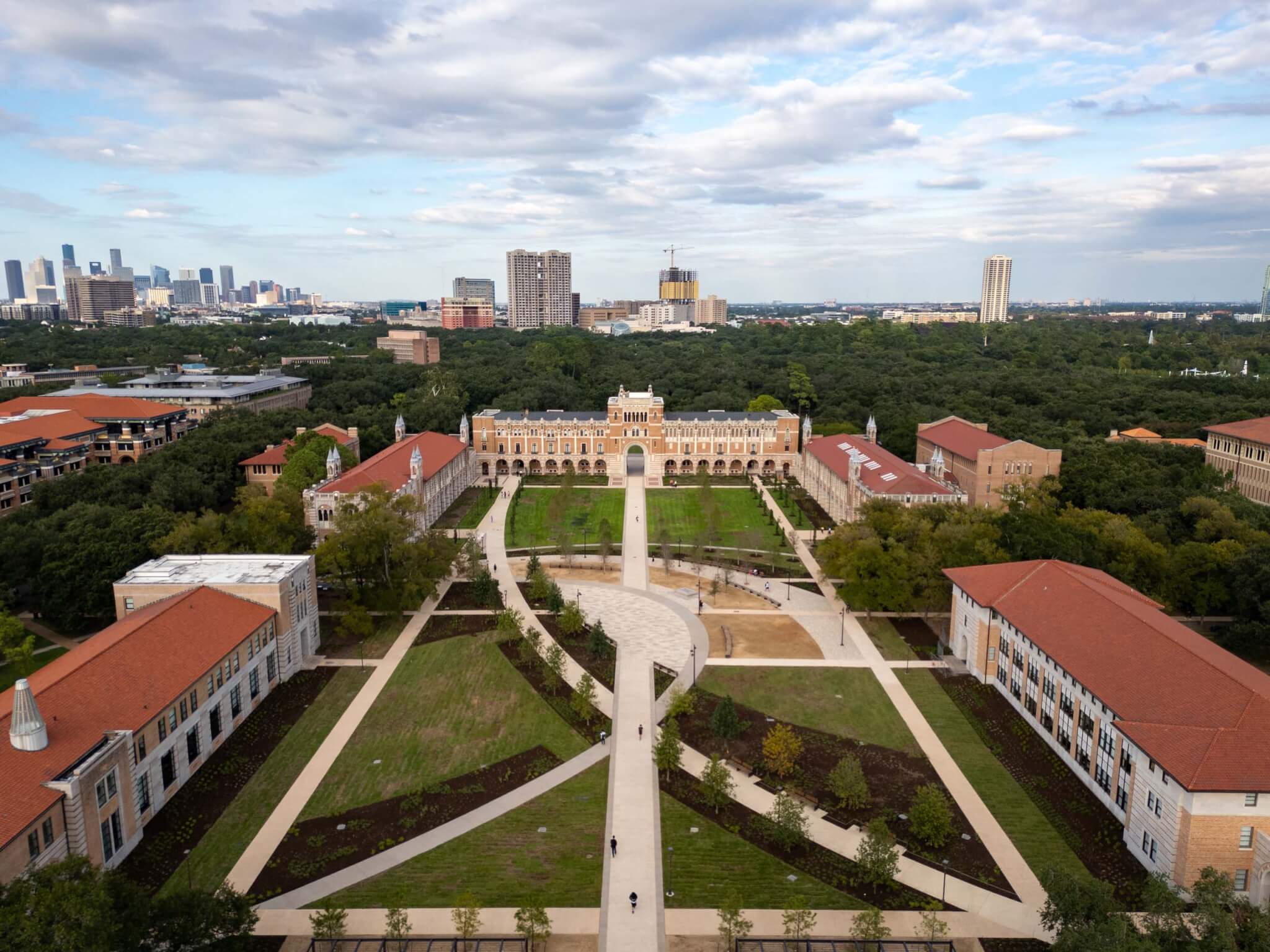Unveiled early in the fall 2024 semester, the central quadrangle of Rice University now has a new look. Thanks to a landscape design by Nelson Byrd Woltz Landscape Architects (NBW), the space has been updated for contemporary academic life. The commission builds on NBW’s track record in Houston, as the firm has redesigned the city’s Memorial Park, the grounds of the Rothko Chapel, and the landscape for the upcoming Ismaili Center.
The axial vistas of the previous version of this important space were first conceived as part of the school’s General Plan, issued in 1910 ahead of Rice’s opening in 1912 and designed by Cram, Goodhue, and Ferguson Architects. Over time the campus grew while the treeless expanse of the Academic Quadrangle remained fixed in time. For years it was stamped with a diagonal desire path that allowed students to cut across the lawn and get to class on time.
NBW began schematic design with a deep dive into the history of the campus and the Texas climate. More than 24,000 new plants were installed around the quad, each carefully selected to feel at home in Houston: species like Echinacea purpurea, Salvia farinacea “Henry Duelberg,” and Penstemon tenuis abound, echoing the school’s blue brand color. There are also 90 new trees on the quad, primed to provide shade as they mature. The vision is that students will one day see a contiguous canopy as they walk the curving pathways beneath the intertwined branches. These will join the campus’s existing live oaks, planted in the school’s early years, that have come to define the experience of moving across the eastern parts of the campus.

NBW’s scheme elaborated the diagonal into an ellipse and added additional curves that swoop across the grounds. In the center of the new space, a paved outdoor common room offers space to meet and gather, as does a mirrored pair of shade structures and benches set in front of Fondren Library.
Beyond serving as a place to study and reflect, NBW’s new quad represents a larger story about Rice University itself. The prior quad boasted a statue of the school’s founder, William Marsh Rice, installed in 1930 on a stone pedestal at the center of the space. In 2019, the school began a process of self-reflection that included the creation of the Rice University Task Force on Slavery, Segregation, and Racial Injustice. The history and presence of the Rice statue was considered, as Rice himself was a slaveowner. A 2021 report offered that the Academic Quadrangle needed “bold change.”

In this update, the school has “recontextualized” the statue of Rice: It now sits at ground level in the southeast corner of the quad.
Other campus elements also inform the new stone and brickwork, like the colonnade of the nearby Lovett Hall, whose influence can be read by astute observers within the new exterior pavement designs.
The removal of linear hedges further opened the quadrangle for events. The new version is capable of hosting gatherings of up to 3,000 people and is the historic location of the school’s graduation ceremonies.

Beyond formal events, the quad was designed for everyday student engagement. The central patio space repurposes the plinth where Rice’s statue once stood: In a move inspired by Speakers’ Corner in London’s Hyde Park, the world’s oldest purpose-built platform for free speech, the granite pedestal now represents the school’s commitment to open discourse on campus and “student-led initiatives,” according to a statement. (The old plinth also contained Rice’s remains, which have now been transferred to a cemetery.) The stone is engraved with a phrase from JFK’s “We choose to go to the moon” speech, given at Rice Stadium in 1962.
The arcs of NBW’s new quadrangle challenge the linearity of the Rice campus’s early buildings and its typical allées. They stand to offer a new suite of habitable outdoor spaces, but only time will tell if their layered symbolic gesture will result in enhanced freedoms for students and the causes they choose to support, today and tomorrow. For now, this significant revision is a physical manifestation of Rice’s ambitious work to create a more equitable future.

